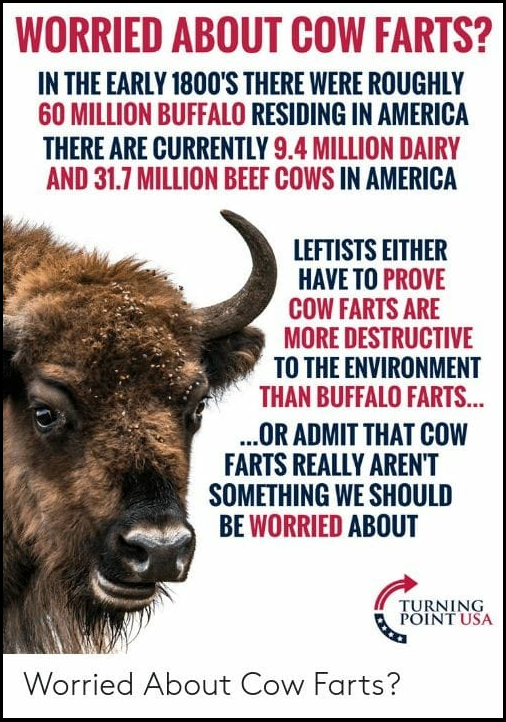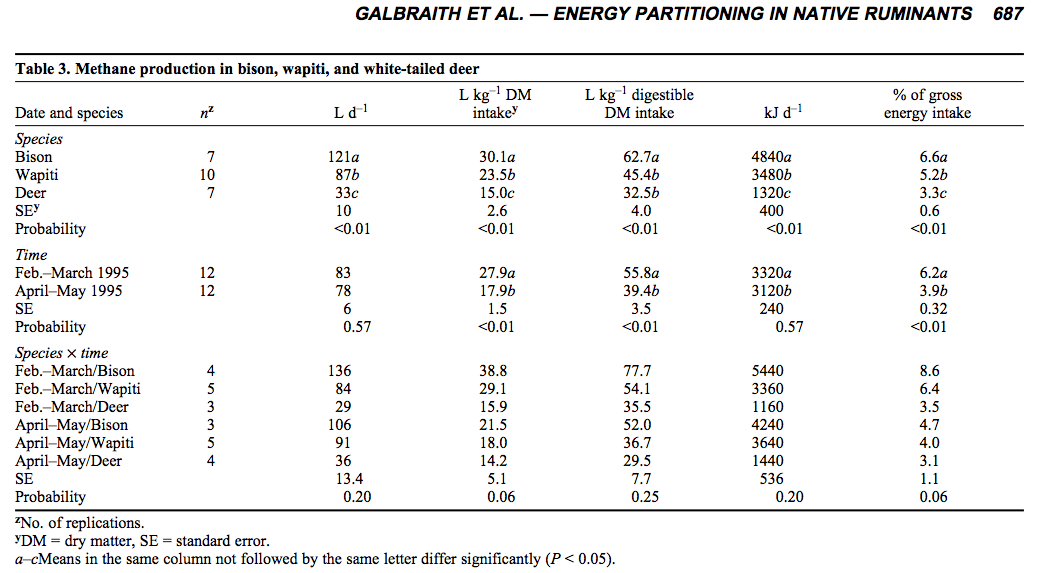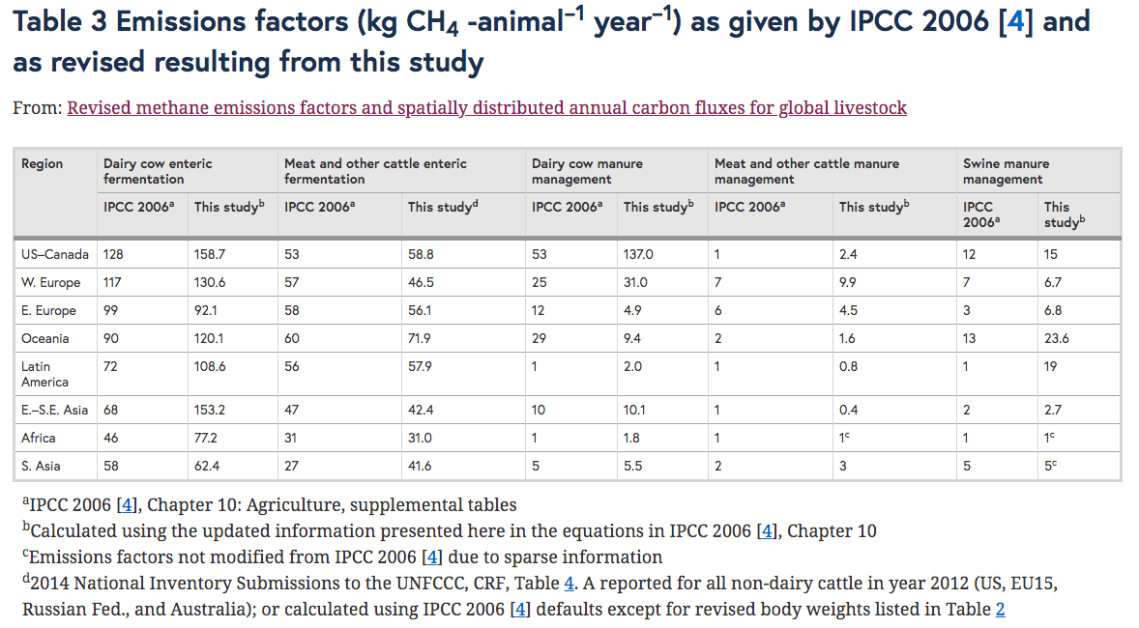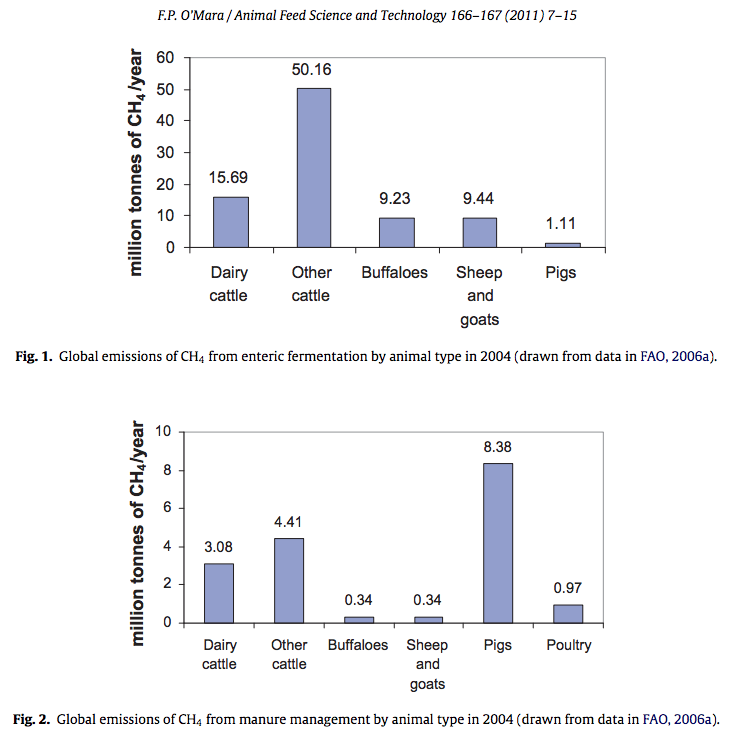Carbon Footprint of Buffalo Compared to Beef

This misleading bison-cattle comparison is making the rounds again.
First, it's important to note that methane (CH4), the gas in question here, has 23-28 times the warming potential as a greenhouse gas compared to carbon dioxide.
Second, it's also important to note that when my (and perhaps your) European immigrant ancestors invaded North America, the bison herds they encountered in the early 1700s on the prairies of the near West were indeed massive. Estimates are that there were between 30 – 60 million individuals. Sixty million is the high end that the bison image is using, but perhaps we can compromise and go with the average of 45 million. However, this estimated bison population was likely near its peak (or even declining) by this time; during the Little Ice Age of the 1300-1800s conditions were ideal in the near western prairies for plant growth and we think the bison population exploded to its 30 – 60 million levels as a result.
Bison Emissions. According to the research, the high end for the methane production of a single bison under controlled conditions and fed sun-cured alfalfa pellets (not prairie forage) is up to 30 kg per year. This is likely unnaturally high because of the unnatural diet the bison were fed in this study. But, since we do not have the natural number, we can go with this higher number. Thus, 45 million bison that roamed the pre-European invasion prairies could have potentially produced 1.35 billion kg of methane per year.

Cow Emissions.Now let's look at cows. On average, mature U.S. beef cows emit between 54 and 62 kg/year of methane for an average of 58 kg/year. Dairy cows emit between 181 and 218 kg/year of methane for an average of 200 kg/year. Both these beef cattle and dairy cow numbers include the methane emissions from the management of the manure the animals produce. But notice, not all "cow" emissions are the same.

There are around 9 million dairy cows and 32 million beef cattle in the U.S. on any given day (2017 data), for 41 million individuals. Thus, the numbers in the bison image are correct! But the claim then challenges us (leftist scientific thinkers?) to show that "cow farts are more destructive to the environment than buffalo (bison) farts."
Okay then.
The 9 million U.S. dairy cows have the potential to produce 1.8 billion kg of methane per year (200 kg/year X 9,000,000 cows). The 32 million U.S. beef cattle have the potential to produce 1.86 billion kg of methane per year (58 kg/year X 32,000,000 cattle). These 41 million dairy cows and beef cattle in the U.S. can produce an average of 3.66 billion kg of methane per year. That's almost three times the methane production of the historical high for bison. Indeed, there would have to have been 180 million bison on the plains for them to produce as much methane as our beef cattle and dairy cows produce today. But the prairie ecosystems, even at their peak production of forage, most likely could not have supported that many bison. Plus, Native American populations, natural predators, competition, and disease were likely doing a nice job regulating the bison at ecosystem carrying capacity.
What is missing from these data are the global beef cattle and dairy cow methane emission numbers. In 2007, the IPCC estimated that livestock were responsible for ~44% of global anthropogenic methane production. In 2004 our global livestock systems were estimated to produce 2.16 trillion kg of methane per year. Estimates suggest that this amount has grown 30% in the last 15 years. Two-thirds (66%) of this amount comes from beef cattle and dairy cows.Note: In the figures below, the buffaloes indicated do not include the farmed and wild American bison that exist today. American Bison are actually not buffaloes.

Eat Less Meat. There are over 9 billion livestock (cattle, pigs, chickens turkeys, etc.) maintained each year in the U.S. and they outweigh the human population by five times. The average U.S. citizen consumes 124 kg (273 lbs) of meat per year, including 44 kg (97 lbs) of beef. Thus, our average beef consumption alone is roughly 0.25 lbs (a quarter pounder!) a day. Moreover, the ratio of non-renewable energy input (its own source of greenhouse gas emissions) to protein energy output in beef production is 40:1. When we add these data to the fact that around 14.5% of total greenhouse gas emissions come from our livestock supply chain, and of that 14.5%, 44% is in the form of methane from dairy cows and beef cattle, it is easy to conclude that our meat consumption is unsustainable on several environmental levels.
If we can find a way to reduce our global intake of meat and milk products over the next decade, we can have a measurable impact on the reduction of greenhouse gas emissions and energy consumption and thus on future increases in the greenhouse effect and global warming.
Posting (and reposting) short, simple claims on social media is risky; they're often misleading, do not tell the whole story, or are completely wrong. Do the research and ask the experts before you use these unsourced claims for your own political or social agendas.
Source: https://mrdrscienceteacher.wordpress.com/2019/09/21/bison-vs-cow-greenhouse-gas-emissions/
0 Response to "Carbon Footprint of Buffalo Compared to Beef"
Post a Comment